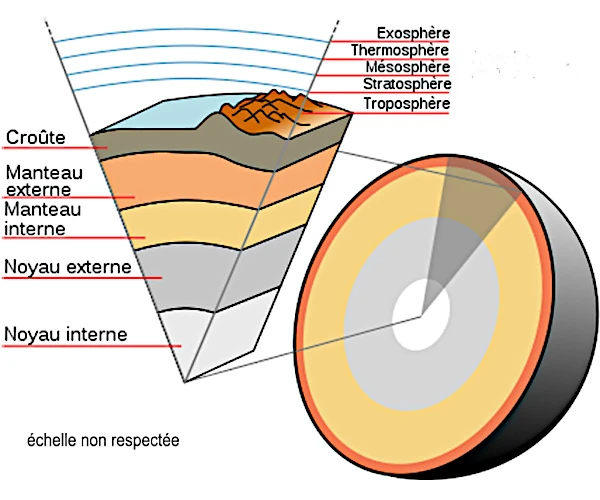
Image: The simplified internal layers of the Earth:
- the solid crust on the surface has a thickness of 65 km,
- the viscous outer mantle, has a thickness 670 km,
- the elastic inner mantle, has a thickness of 2180 km,
- the liquid outer core, has a thickness of 2270 km,
- the solid inner core, has a thickness of 1220 km.
Earth is a very complex planet that has different layers inside and outside. The outer layers of the Earth are the crust, the mantle and the core. The crust is the outermost layer of the Earth and it is the one on which we live. It is divided into two types: continental crust, which forms the land surface, and oceanic crust, which forms the bottom of the oceans. Below the crust is the mantle, which is much thicker than the crust and is made of very hot, very soft rocks. Finally, the core is the deepest layer of the outer layers and is mostly made up of liquid metals.
The inner layers of the Earth are the outer core and the inner core. The inner core is the deepest layer on Earth and is mostly made up of solid metals, such as iron and nickel. The outer core is the layer just above the inner core and is mostly made up of liquid metals.
In addition to these inner and outer layers, the Earth also has atmospheric layers. The Earth's atmosphere is the layer of gas that surrounds the planet. It is divided into five main layers: the troposphere, the stratosphere, the mesosphere, the thermosphere and the exosphere. The troposphere is the layer closest to the Earth's surface and is where most weather phenomena, such as rain and snow, occur. The stratosphere is the layer just above the troposphere and is where the ozone layer is located which protects the Earth from the sun's harmful UV rays.
By understanding the different layers of the Earth and its atmosphere, we can better understand our planet and how it works. The different layers have different properties and functions, and all are important for sustaining life on Earth.